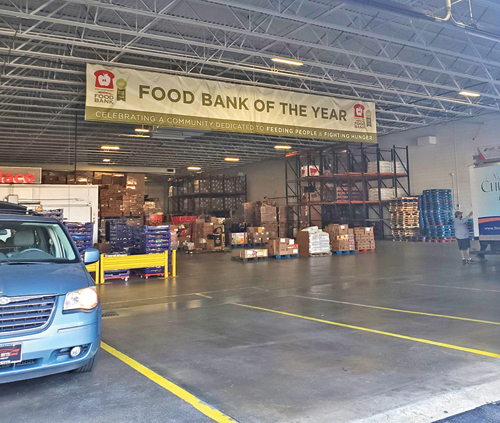Pandemic triggered positive changes at food bank
by Laura Bednar
Many companies adapted their work models during the pandemic, including the Akron-Canton Regional Foodbank. Many initiatives the food bank developed in 2020 inspired the organization’s three-year strategic plan, which launched in mid-March.
CEO and food bank President Dan Flowers said the pandemic brought about “a dramatic era of change.” The food bank was concluding its 2015 five-year strategic plan, including building a location in Canton, when the shutdowns began.
Flowers said 42 members of the National Guard came to the Akron Foodbank to help distribute food in May 2020 and didn’t leave until the summer of 2021. National Guard members delivered food to homes in need, making 1,000 food drops in 2020.
Flowers said food bank employees pre-packaged food boxes (visitors usually chose their own food). Ten thousand pre-packaged boxes were delivered to homes in 2020 using DoorDash, which offered to deliver the goods for free.
The food bank previously did not have a delivery program, and after DoorDash suspended its free delivery service, the organization recruited volunteer drivers to maintain a home delivery system.
These changes are only some of what fueled the food bank to take a more personal approach in its strategic plan. “We received new support for who we became after the pandemic,” Flowers said.
“Deepening Our Impact,” the title of the strategic plan, focuses on five stakeholders: neighbors, communities, investors, food bankers and the food bank itself.
Neighbors are defined as people seeking help with groceries across the eight counties the food bank serves. The food bank plans to solicit feedback from neighbors, accommodate food needs related to nutrition and reduce the stigma associated with using the food bank.
The food bank wants to connect with communities–which can be urban, suburban or rural–through community advisory committees and a partner leadership academy, according to the strategic plan. Strengthening relationships with other social service and community organizations is part of this goal.
Flowers said the food bank wanted community voices to be part of the organization, as it serves eight diverse counties.
Investors, or the people and organizations that donate food, time and money, will be made aware of the food bank’s need for ongoing support. The plan also states the food bank will celebrate and engage volunteers to make them feel appreciated and cultivate relationships with companies that donate food. Flowers said he saw more partner agencies close during the pandemic than ever in his career. He has been CEO for 20 years.
“A shift in this result was making new partners,” he said, adding that the food bank also saw many first time food donors during COVID.
The food bank will retain and connect with food bankers, or employees, by creating an engaging culture and offering professional development opportunities.
The largest piece of the puzzle is the current expansion at the Akron location at 350 Opportunity Pkwy.
Flowers said there was an extra acre of land on the south side of the Akron building, and while building another food center in Canton was helpful, it did not end the bottleneck in the area. A 15,000-square-foot addition at the Opportunity Parkway center will include doubling the size of the coolers and freezers, updating office space and creating a food pantry. Upgrades are projected to be complete by the end of this year.
The on-site food pantry will initially be operated limited hours but will likely open three to four days a week once established. Those living at 200% or below the federal poverty line are eligible to receive support from the food bank.
Flowers said there are 74,864 recipients of Supplemental Nutrition Assistance Program benefits, which assist needy families in purchasing food. During the pandemic, the U.S. Department of Agriculture gave a temporary boost to these benefits, adding emergency allotments. USDA reported that the emergency allotments ended after February of this year. Flowers said changes in the economy (like current inflation rates) and the loss of benefits results in a greater need for the food bank.
The food bank was visited by 81,779 people in 2022, and this year it has seen 109,511 unduplicated visitors. Flowers said that is a 34% increase.
“It takes time for people to adjust when a benefit goes away,” he said. “People develop coping strategies, and the numbers will trail down as people adjust. But I think the number [of visitors] will hold higher overall.”
Flowers said the food bank provides on-site services such as early pregnancy care, vaccinations and voter registration in addition to food. The food bank also hosts caseworkers and other community partners who can meet with those in need.
“Receiving emergency food is a gateway to getting out of poverty,” said Flowers. He added that the food bank is currently talking with the Alcohol, Drug Addiction and Mental Health Board about potentially installing a Narcan-dispensing machine for overdoses.
With the strategic plan in motion, Flowers said the first priority is completing the Akron expansion. Once the facility is complete, the foodbank can work to enlarge its community outreach and program offerings.
“People won’t see a radically different food bank but one that is more focused and client-centric,” said Flowers.
For more information or to find volunteer opportunities, visit akroncantonfoodbank.org. ∞

load food into their vehicles in the food pickup area. Photo
by Laura Bednar.
